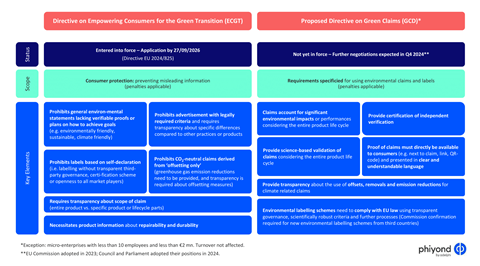Marketing and sustainability teams in the sports and outdoor industry face growing scrutiny from eco-conscious consumers who are increasingly sceptical of green claims. At the same time, two new EU directives directly affect green claims and aim at regaining consumer trust. This expert article written by Dr. Diana Born provides a four-step approach applicable to every green claim offering best practices to ensure both consumer trust and alignment with science-based EU regulations.
Current state of green claims and consumer trust
Target groups in the sports and outdoor industry are aware of the connection between consumption and its environmental footprint: they use sustainability features as criteria for their buying decision. Hence, green claims such as ‘environmentally friendly’, ‘sustainable’ and ‘climate neutral’ have become popular in product communication in the past years. Furthermore, brands and retailers developed labelling schemes for their products featuring improved sustainability performance such as ‘Vaude Green Shape’, ‘Salewa Committed’ or Globetrotter’s ‘Eine grünere Wahl’ (‘A greener choice’).
Diverse studies by authorities, consumer associations, and environmental organisations revealed that many claims and labels used in the EU fail to withstand thorough examination, often falling into the category of ‘greenwashing’ (see for example ref[1]). Current sustainability communication practices have led to a series of warnings and court rulings due to misleading advertising. Existing legislation, including the German Act against Unfair Competition, already addresses these issues across many EU countries. Vague green claims combined with the increasing number of lawsuits have resulted in unsettled consumers: already in 2021, a Deloitte & OutDoor by ISPO Consumer Report revealed that only 30% of study participants trusted brand’s sustainability claims[2].
→Find out more about consumer’s relationship with brands in Fredrik Ekström’s article
Two EU directives empower consumers’ decision-making through requirements for green claims and labels
As part of the Green Deal, the EU aims to reach net zero greenhouse gas emissions by 2050 and decouple economic growth from resource consumption. To achieve this, the European Commission has not only set up new schemes and directives for its member states, but also uses levers on both company and consumer level. Regarding the point of sale, two directives target product communication and are relevant for corporates: the Directive on Empowering Consumers for the Green Transition (ECGT) and the Green Claims Directive (GCD) (see fact sheets). The ECGT Directive already entered into force and needs to be applied by companies by Sept 27, 2026, while the proposed Green Claims Directive is still under negotiation[3]. Both directives aim to improve product communication about environmental performance by requiring evidence-based claims. Vague assertations and self-declarations are prohibited whereas external third-party verification is mandated.

What do these green claim directives mean for product communication?
The EU directives result in the need to establish new processes, e.g. for data exchange with sustainability departments and external verifiers. Hence, they cause more costs, at least in the setup phase. Therefore, some companies may decide to refrain from using green claims or labels due to insufficient data or reputational and financial risks. On the other hand, these directives offer products with clear environmental benefits the potential to stand out: recent McKinsey studies in the US and Germany revealed that retail sales and real consumer willingness to buy are higher for products that feature sustainability claims[4].

Four steps to prepare green claims for the new EU directives
1. MATERIAL: Focus on what matters
Highlight improved environmental features that result in a significant difference across the entire product life cycle. Avoid claims about packaging, a small component or minor logistical improvements, as these may be misleading. Science-based information about product footprints can be derived from life cycle assessments that were carried out according to, for example, the product environmental footprint (PEF) methodology proposed by the European Commission[5] or the ISO 14040/44 standard.
2. COMPLETE: Address both positive and negative effects
Measures that improve one environmental footprint aspect of a product may result in negative effects on another footprint part or even outside of the product’s lifecycle . For example, claims about recycled content should be transparent about the material sourcing and end of life. Using bottle PET as recycled material for textiles may decrease the textile product’s carbon footprint on the one hand. On the other hand, regional PET bottle cycles may need to source more fossil-based virgin material and PET may undergo downcycling since textile-to-textile recycling is not widely applied yet[6].
3. PRECISE: make information supporting the claims easily accessible
If claims are used, information should be precise (e.g. percentage of greenhouse gas emission reduction, clearly indicating the reduction scope and base year) and understandable by diverse target groups. If the packaging does not allow placing all required information near the claim, it can be provided through a link or QR code.
4. VERIFIED: get independently certified
Environmental labels and claims should undergo independent third-party verification based upon transparent, science-based criteria and clear governance processes accompanying the certification process. An example of a scientifically sound labeling scheme with ambitious environmental criteria is the EU Ecolabel that is available for diverse product groups involving e.g. clothing and textiles[7]. Ecolabel criteria for textile products are currently under revision and stakeholders can get involved. This is a great opportunity for brands and organizations active in the sporting goods and outdoor industry to add their expertise and challenges (e.g. deriving from performance textiles) to the process.

Takeaways for marketing departments
- Use internal knowledge & data: sustainability & product departments may be able to provide relevant data as a base for claims.
- New processes are necessary: sustainability or legal departments or external advisors may need to be involved to develop and check claims.
- Capacity building: since the capacities of sustainability departments are limited, it can be helpful to prepare claim guidelines together and develop a certain understanding of environmental data deriving from life cycle assessments in your marketing and communication teams.
- Less with higher quality, digital & slower: Product communication may need new digital tools and more preparation time due to transparency needs and certification processes. Therefore, focusing on claims with both high impact and differentiation potential is key.
Sources:
[1] eur-lex.europa.eu/legal-content/EN/TXT/PDF/?uri=CELEX:52022SC0085
[2] Outdoor_Consumer_Report_2021.pdf (deloitte.com)
[5] European Platform on LCA | EPLCA (europa.eu)
[7] EU Ecolabel - Clothing and Textiles (europa.eu)
About the author
Dr. Diana Born is a manager at phiyond by adelphi. Building on her experience as research scientist and industry consultant, she is an expert for science-based sustainability strategies, business models and green communication.
phiyond by adelphi is a transformation companion for sustainable and responsible business practice. The company draws on over 20 years of experience in sustainability research and policy consulting. They provide a profound and comprehensive understanding of systemic change, enabling them to shape the sustainability transformation with companies. Their approach extends beyond simply advising on sustainability: phiyond by adelphi provides guidance through the entire transformation process: from strategy and vision to a clear roadmap and its implementation, to internal and external communication and reporting - in the areas of climate & decarbonization, resources & circular economy, and human rights & due diligence.
Is your brand ready for the sustainable consumer?
Eco-conscious consumers are reshaping the sports and outdoor industry. Discover the latest trends and strategies to stay ahead in our special series.
>> Find out more





























